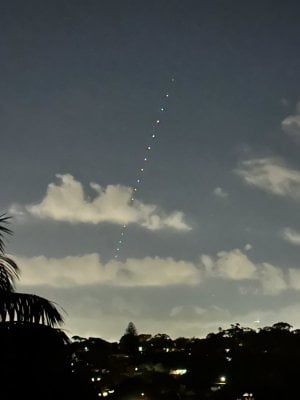Unusual phenomenon leaves Aussie stargazers in awe
By
VanessaC
- Replies 0
Stargazers in a major city were treated to a dazzling surprise this past Sunday night when the skies above displayed a rather unusual cosmic parade: a series of bright, square lights arrayed in a perfect line.
All across the major urban centre, the skies were adorned with celestial jewels.
The spectacle, spotted in the skies above Sydney, left many residents staring at the sky in amazement and confusion, with social media abuzz with images, videos, and speculation.
But what were these strange lights that captured the imaginations and curiosity of so many?
As it turns out, these were no visitors from another world, nor were they shooting stars or any kind of atmospheric anomaly.
The true identity of these lights is both more worldly and futuristic: they are Starlink satellites, a technological enterprise owned by visionary entrepreneur, Elon Musk.
'The lights are what is described as a constellation of satellites,' University of Southern Queensland Astronomer Jonti Horner said.
'So rather than one or two, there are a whole heap of them…and it’s a number that’s actually growing really rapidly.'
Starlink is a venture into providing high-speed internet across the globe, especially in remote areas where traditional infrastructure falls short.
To accomplish this, Musk's company SpaceX launched over 5,500 satellites into orbit, with plans to increase that number by thousands.
'That number is going to climb over the coming years to as high as 40,000,' Horner added.
The Starlink satellites ascend to space, but it takes time for them to reach their proper operational altitude.
'It’s a bit like when you’re on an aircraft, after you’ve taken off, you don’t just immediately get to 40,000 feet, it takes time to get up there…and that’s what we’re seeing here,' Horner explained.
'And they get to an altitude at which point they are much more visible and are grouped together so you see them as a line of dots moving across the sky.'
'Almost like a centipede or caterpillar in the night sky.'
While Starlink's mission to provide universal internet access is undoubtedly groundbreaking, its execution does not come without controversy.
Astronomers and environmentalists have voiced earnest concerns about the potential impacts of such a substantial increase in low Earth orbit traffic.
The introduction of thousands of satellites has also raised issues of light pollution, as the artificial brightness and reflections can obscure the natural state of the night sky.
'It does get very contentious,' Horner claimed.
'In terms of internet access, it is fabulous. But on the flip side…they’re polluting the night sky and causing a glow that people can control.'
Furthermore, for many cultures, the stars are not just scientific phenomena; they are a canvas for mythology, a guide for navigation, and a sacred part of the cultural heritage.
'And you can’t consent to this, and this has become particularly important for people from different cultures who have a really deep connection to the night sky.'
 What are your thoughts on this latest development from Starlink? Share your thoughts with us in the comments below!
What are your thoughts on this latest development from Starlink? Share your thoughts with us in the comments below!
All across the major urban centre, the skies were adorned with celestial jewels.
The spectacle, spotted in the skies above Sydney, left many residents staring at the sky in amazement and confusion, with social media abuzz with images, videos, and speculation.
But what were these strange lights that captured the imaginations and curiosity of so many?
As it turns out, these were no visitors from another world, nor were they shooting stars or any kind of atmospheric anomaly.
The true identity of these lights is both more worldly and futuristic: they are Starlink satellites, a technological enterprise owned by visionary entrepreneur, Elon Musk.
'The lights are what is described as a constellation of satellites,' University of Southern Queensland Astronomer Jonti Horner said.
'So rather than one or two, there are a whole heap of them…and it’s a number that’s actually growing really rapidly.'
Starlink is a venture into providing high-speed internet across the globe, especially in remote areas where traditional infrastructure falls short.
To accomplish this, Musk's company SpaceX launched over 5,500 satellites into orbit, with plans to increase that number by thousands.
'That number is going to climb over the coming years to as high as 40,000,' Horner added.
The Starlink satellites ascend to space, but it takes time for them to reach their proper operational altitude.
'It’s a bit like when you’re on an aircraft, after you’ve taken off, you don’t just immediately get to 40,000 feet, it takes time to get up there…and that’s what we’re seeing here,' Horner explained.
'And they get to an altitude at which point they are much more visible and are grouped together so you see them as a line of dots moving across the sky.'
'Almost like a centipede or caterpillar in the night sky.'
While Starlink's mission to provide universal internet access is undoubtedly groundbreaking, its execution does not come without controversy.
Astronomers and environmentalists have voiced earnest concerns about the potential impacts of such a substantial increase in low Earth orbit traffic.
The introduction of thousands of satellites has also raised issues of light pollution, as the artificial brightness and reflections can obscure the natural state of the night sky.
'It does get very contentious,' Horner claimed.
'In terms of internet access, it is fabulous. But on the flip side…they’re polluting the night sky and causing a glow that people can control.'
Furthermore, for many cultures, the stars are not just scientific phenomena; they are a canvas for mythology, a guide for navigation, and a sacred part of the cultural heritage.
'And you can’t consent to this, and this has become particularly important for people from different cultures who have a really deep connection to the night sky.'
Key Takeaways
- Stargazers in Sydney were puzzled after witnessing an unusual sequence of bright, square lights in a row in the night sky.
- The lights, which were spotted on Sunday, were identified as Starlink satellites by an astronomer from the University of Southern Queensland.
- More than 5,500 Starlink satellites, owned by Elon Musk, have already been launched, and the number could increase to as high as 40,000 in coming years.
- While the satellites offer highspeed internet, they have also sparked concerns regarding light pollution and cultural impacts on night sky observation.








